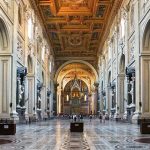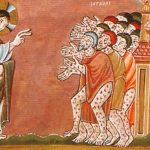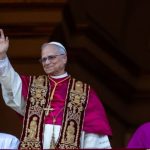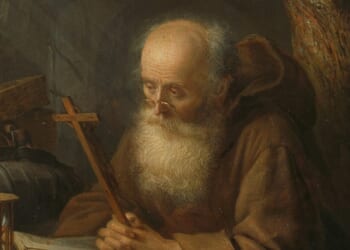On November 9th, the Church celebrates the feast of the Dedication of the Basilica of St. John Lateran in Rome. Every year when this feast comes up, I am always taken a bit by surprise, as it is one of the rare occasions in which a liturgical feast does not honor a saint or some aspect of the life of a saint. Rather, we celebrate a building—specifically, its “dedication.” Of course, when the Church instituted this feast, the purpose was not to celebrate a man-made structure for its architectural design and beauty. The purpose was to celebrate what this structure represents: a sign of our love for and union with the See of St. Peter, Vicar of Christ.
Understood in this light, this celebration makes a lot more sense and is actually a wonderful feast to acknowledge! But perhaps there is more that we can glean from this feast than simply the celebration of the official ecclesiastical chair of the Bishop of Rome, one whose dedication took place after Christians were granted religious freedom under the Roman Emperor Constantine in the year 324. Perhaps there is more to this feast than only a memorial of times past. Perhaps there is something to understand about what this feast means for us now.
Let’s begin by acknowledging how the Apostles, the early Christian martyrs, and the numerous saints since have all worked to “lay a foundation” which is ever being “buil[t] upon” (1 Cor. 3:10-11). We are not just members of a two-thousand-year-old institution. We are members of a “living and effective” Church (Heb. 4:12), one that St. Paul refers to as a “body” in Christ.
Our modern Church is accustomed to this terminology, but the members of the early Church must have been scratching their heads. What could Paul have meant by saying that one person is a foot, the other an eye? Certainly, they would have understood the analogy that all parts of one’s body are wanted and needed, but they would have also sensed something distinctly literal about Paul’s words. Though perhaps they could not have fully comprehended what he meant, the people would have understood that this was no simple analogy.
Do you not know that you are the temple of God, and that the Spirit of God dwells in you? (1 Cor. 3:16)
What Paul is trying to get the people of Corinth to understand is that “going to Church” would not be the same as attending services at the synagogue on the Sabbath. The people would have to be “transformed by the renewal of [their] mind” (Rom. 12:2) if they were going to accept the new wineskin that Jesus was offering. What is this new wineskin that they are being asked to accept?
“Destroy this temple and in three days I will raise it up.” The Jews said, “This temple has been under construction for forty-six years, and you will raise it up in three days?” But he was speaking about the temple of his Body. (Jn. 2:19-21)
For the first time, the baptized children of Israel are being offered a dwelling place with God that would be so close, so united, that it would reside in the very silence of their hearts! The human heart would now be the temple! But how could this be possible? How could they be with God if they did not go to the physical place that was constructed specifically to pay Him worship? How could Jesus be offering something that to this point had been impossible for them?
Only one way. They would be united to Jesus by becoming a part of His very body.
The bread that we break, is it not a participation in the body of Christ? (1 Cor. 10:16)
The new wineskin that Jesus was offering the Jewish Christians was a participation in His Eucharistic Bread—His very flesh—so that now, “if [they] receive the Eucharist worthily, [they would] become what [they] receive” (St. Augustine). It is for this reason that the Lord would reside within them continually and eternally, in the temple that is their hearts.
It is for this reason that we can sincerely believe that “the gates of the netherworld shall not prevail against” our Church (Mt. 16:18), no matter how many Church buildings are sold or destroyed. There is no one so strong that can destroy the temple of our hearts, because the heart is the one place that can only be possessed by the one to whom we choose to give it. As long as our choice is to give our hearts to Christ, then we safely reside in our living, breathing Church.
Of course, this is not to deny the very hard reality that witnessing what is happening in our Church today is heartbreaking: bankrupt dioceses, Church closings, division among the laity, even corruption among some clergy. We believe that the “gates of the netherworld shall not prevail,” but on the other hand, the “netherworld” is putting forth a mighty effort! How do we hold onto hope when all evidence points to the contrary?
“It is peculiar to the Church to nourish most when persecuted.” – St. Hilary
In perhaps one of the greatest mysteries of the spiritual life, it is in times of suffering and apparent destruction that our temple grows. It certainly does not feel that way when we are in the midst of suffering, but we need only look back in time to know that it is true. From the persecutions of the early Church came the greatest Apostle to the Gentiles of all time, St. Paul. And where would our Church be now without the saints that rose up from the nineteenth century revolution in France—St. John Vianney, St. Thérèse of Lisieux, St. Catherine Labouré? In our own modern times, the saints that God has given us throughout a century of war and depravity—St. Faustina Kowalska, Pope St. John Paul II, St. Mother Teresa of Calcutta—have all served to strengthen the temple, providing just the support beams necessary to keep the structure steady. Our temple is better for it, precisely because it has been fortified after enduring a terrible storm.
On this feast of the Dedication of the Basilica of St. John Lateran in Rome, let our hearts be ever grateful for the “indestructible” See of St. Peter, Vicar of Christ. Let us honor the many saints who have come before us, planting the seeds and building the foundation of the Church—at times, by their very blood. But let us also recognize our own mission now, which is to continue to provide the support beams necessary to keep the structure steady—even if it is no more than one small block of wood. No member, big or small, is any less necessary to the body of Christ, and as long as we keep the love of Christ at the center of our hearts, we can be sure we will be doing our part to build up the kingdom of God.
Author’s Note: Excerpt from: The Safe Haven: Scriptural Reflections for the Heart and Home (Ordinary Time Weeks 29-34). To purchase, visit Amazon or The Catholic Company, where all other volumes currently in print are also available.
Photo by Nick Castelli on Unsplash














